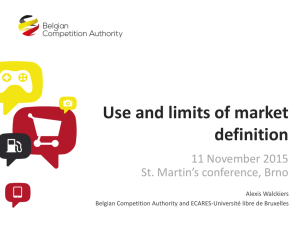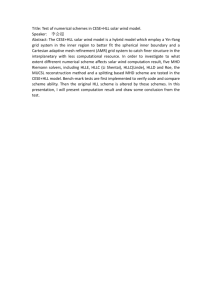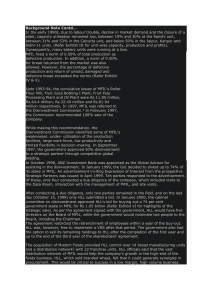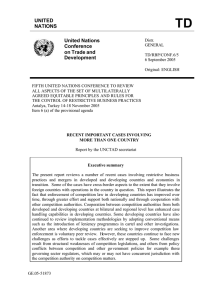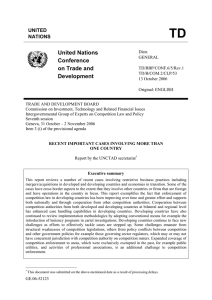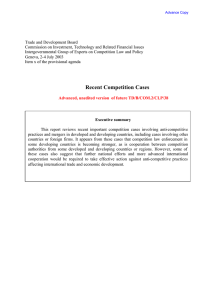CPL Benefits to Consumers_Pradeep S Mehta
advertisement
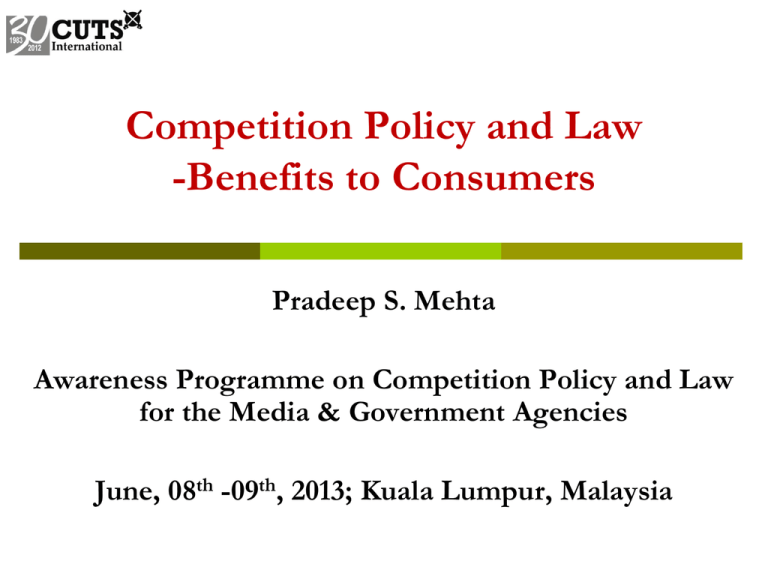
Competition Policy and Law -Benefits to Consumers Pradeep S. Mehta Awareness Programme on Competition Policy and Law for the Media & Government Agencies June, 08th -09th, 2013; Kuala Lumpur, Malaysia What is Competition? The process of rivalry between firms striving to gain sales and make profits Motive: self-interest, but outcome mostly beneficial for the society Competition is not just an event, but a process It is not automatic – needs to be nurtured 2 Types of Competition Price Competition: Winning customers by lowering price Non-price Competition: Winning customers by advertising, offering after-sales-services, using sale promotion tools, etc. 3 Ways of Competition Fair Competition: Fair means such as producing quality goods, becoming cost-efficient, optimising the use of resources, best technology, research & Development, etc. Unfair Competition: Unfair means such as fixing price with the rivals, predatory pricing, disparaging or misleading advertisements, etc. 4 Competition Enforcement and Consumer Welfare Anti Competitive Practices restricting access Competition Authority’s Enforcement Actions Poor quality goods/services by a firm abusing dominant position Tied-selling restricting consumer choice Anti Competitive Practices leading to excessive prices ACCESS QUALITY Consumer Welfare CHOICE PRICE 5 Benefits from Competition Efficiency Innovation Check on concentration Check on corruption Economic growth (wealth and job creation) Consumer welfare gains: Easy access Consumers in developing countries do not generally consider competition to be an issue of any relevance, yet it is consumers who have the most to gain from CP through lower prices, more choice and higher quality in the goods and services that they can buy. 6 Myths & Realities Myth: Competition policy and law will allow foreign firms to come in and undermine domestic firms. Reality: Effect of foreign entry depends upon capabilities of domestic firms. Competition Law protects domestic firms from ACPs of foreign firms. Example: There are instances and experiences from various countries where multinationals had to pay heavy fines for their engagement in anti-competitive activities. One of these is the vitamin cartel where several leading and sophisticated drug manufacturers were involved in a global conspiracy to fix the prices of bulk vitamins. Action was taken against the cartel in the US, European Union EU), Canada and Australia, as a result of which a fine of over a billion dollars was levied on the perpetrators. Even Brazil, a developing country took action by getting cooperation from the US Department of Justice. 7 Myths & Realities Myth: Competition policy and law are the tools for rich and urban societies. Reality: Poor do benefit from action against competition abuses, if they can access justice. Example: Rukmini Devi, a poor, elderly and illiterate widow applied for loan from the local cooperative bank for her small farm. Rukmini Devi was required to affix passport size photographs to the loan papers. She got one of the two local studios to get her photo taken but she was asked to pay a hefty price. Thus she did not get the loan and was forced to go to a usurious money lender. Both the studios, it emerged, were in league with the bank manager and the moneylender. Rukmini Devi complained to the local district forum under the Consumer Protection Act (COPRA) against the studio owners, and got relief. 8 Myths & Realities Myth: Competition law and policy works for the rich and affluent sections only. Reality: Competition law and policy can also benefit the poor Example: In the 1990s in Rajasthan, when government ration shops started selling goods like razor blades, tea, etc. at higher than market prices; poor consumers did not buy them. As a solution, ration shops started tied selling, i.e. the consumer had to purchase a quantity of tea and razor blades if they had to pick up the required quota of wheat and/or kerosene. This practice was stopped only when the consumer movement protested. Thus, competition policy and law can also benefit the poor 9 Competition benefits to consumers: Case Studies Healthcare In a landmark case, Bristol-Myers Squibb Co. had to pay more than US$515mn to settle fraud allegations involving kickbacks to doctors and inflated drug prices. Bristol was also accused of conniving with Apothecon, for setting and maintaining fraudulent and inflated prices. In July 2005, the Competition Authority of Argentina found four medical oxygen foreign companies, viz Air Liquide (France), Praxair (US), AGA (Germany) and Indure (Chile), guilty of entering into an agreement to distribute customers among themselves and also bid rigging. The Authority levied a fine of amounting to US$24mn on these companies. 10 Case Studies….. Food Mauritians have to rely upon powdered milk to meet their and their children's nutritional demand as fresh milk was not available in the country. The powdered milk market was dominated by a handful of players. One of them enjoying 60 percent of the market share (clearly a dominant position) decided to raise the prices of the product abruptly. The price rose to a peak Mauritius Rupees (MUR) 190 per kg during 2004-2006. Pursued by continuous lobbying by the Institute for Consumer Protection (ICP), CUTS local partner, the government eventually intervened in the market and fixed the margin of profit for the sector at 14 percent. This led to decrease of price, which later stabilised between MUR 90-120 per kg across the country. 11 Case Studies….. Food In a case in 1995 in Ukraine, the Vinnysta Meat Industry and Vinnysta Milk Processing Industry, joint stock companies were monopolies in relevant regional markets of meat products and butter, respectively. Both enterprises increased wholesale prices for meat and milk products to the level of monopolistic prices. Moreover Vinnysta Milk Processing Industry had previously decreased the production volumes of butter, which caused shortage of this product in the market. After the authorities took action, the two ceased violating the regulations and remitted the illegally gained profits to the state budget. 12 Case Studies….. Public Transportation-1 To leave for Siem Reap, the most popular tourist town in Cambodia, boats are the most popular means, especially for tourists. Boat transportation services are provided by eight private companies. Competition among these boat companies drove down the prices beyond the profitable level and thus caused extensive losses to some of the boaters. The companies decided to sit down together and resolve the problem. Even though no written agreement was recorded, the companies agreed to fix their service prices to 40,000 riles for Khmer nationals and US$20-25 for foreigners. There is no competition law yet in Cambodia and hence action against the cartel of boaters has not been taken. However, the local authority can take action under some other laws. 13 Case Studies….. Public Transportation-2 In 2003 in Tanzania Consumers Protection Association (TCPA) lodged a complaint with the Fair Competition Commission against petroleum companies that decided to raise petrol prices in pursuit of profits without any increase in corresponding cost price of petrol. Consequent to the rise in fuel prices, bus fares and food prices also rose. The complainants threat to litigate and publicise the issue provoked the opposition. The publicity forced the government to act in a firm manner by threatening to cancel the licences of any bus service provider who hiked prices. Consequently, bus operators reverted to old fares. 14 Case Studies….. School Uniforms In Korea three school uniform makers hindered the cooperative buying plan launched by the Parents Association, and agreed not to supply to the sales agencies participating in such cooperative buying. Such a practice was in violation of Article 19 of the Monopoly Regulation and Fair Trade Act (MRFTA). KFTC imposed a surcharge of US$8651.52, and prosecuted seven individuals and four entities. This case was significant as it involved both horizontal and vertical cartels, and had direct effects on consumer welfare. 15 Case studies… Breaking monopoly in Bhutan Hindustan Lever Ltd. was operating in Bhutan through just one distributor: The Tashi Group of Companies. The Ministry of Trade and Industry (MTI) insisted that HLL appoint a parallel distributor and suggested Food Corporation of Bhutan (FCB), a government company, which had both capital and a wide distribution network. Yet when HLL did not respond, MTI threatened that it would adopt a policy that no firm in Bhutan can act as sole distributors for any company, thus cancelling Tashi’s license to operate as HLL’s sole distributor. The threat worked and HL soon appointed FCB as its second wholesaler. In turn, it was HLL which gained hugely. FCB soon multiplied HLL’s business in Bhutan three fold. 16 Need for Merger Regulations Malaysia’s competition regime only regulates cartel behaviour and abuse of dominance. Merger regulations are not part of the Competition Act currently, ostensibly due to business lobbying Mergers, both domestic and international, can have a great impact on national economic development and consumer welfare There are also direct impacts on consumers in terms of higher prices, poor standards and restrictions on the products that they have access to 17 Need for Merger Regulations Case study from Zimbabwe The Competition & Tariff Commission authorised the merger of the local businesses of British American Tobacco (Zimbabwe) Limited and Rothmans of Pall Mall (Zimbabwe) Limited, after imposing certain terms and conditions. It could not stop the merger as their parent companies in the US and UK had merged. BAT and Rothmans proposed that they will strip one plant, because only one is sufficient to cater to the demand. The imposition was based on the anticipated benefits of the merger, as promised by the merging parties, and was designed to alleviate the adverse effects of the merger. The merged company was required to a) sell one plant to a local business, which it did, and b) consult the Commission every time it proposed a price increase; the merging parties should allow competitors to operate in related downstream industries. 18 Lessons for Malaysia Competition enforcement leads to consumer and producer welfare Stakeholders need to recognize their role in promoting competition Policymakers/Government need to prioritise competition reforms MYCC to create a public buy in Consumer movement: natural allies of a competition regime Need to empower MyCC with powers to review Mergers 19 THANK YOU! psm@cuts.org www.ccier-cuts.org 20



